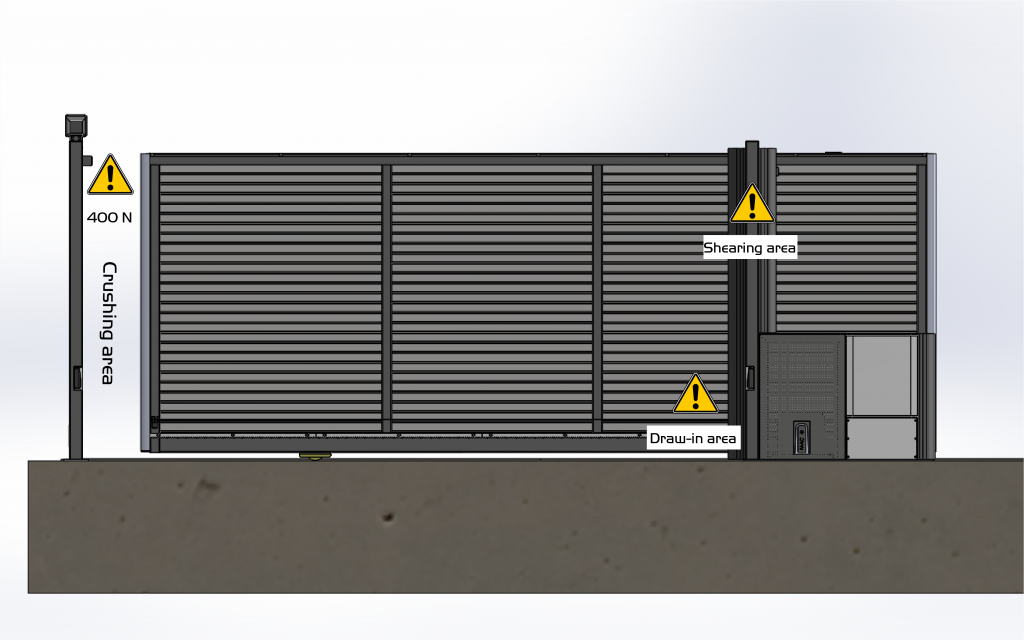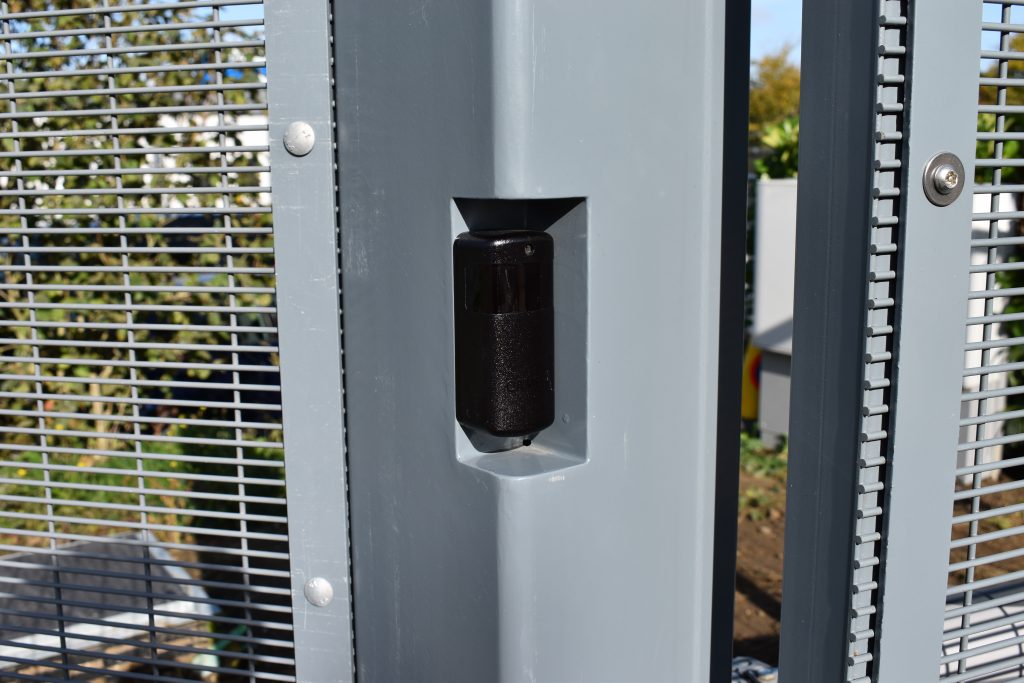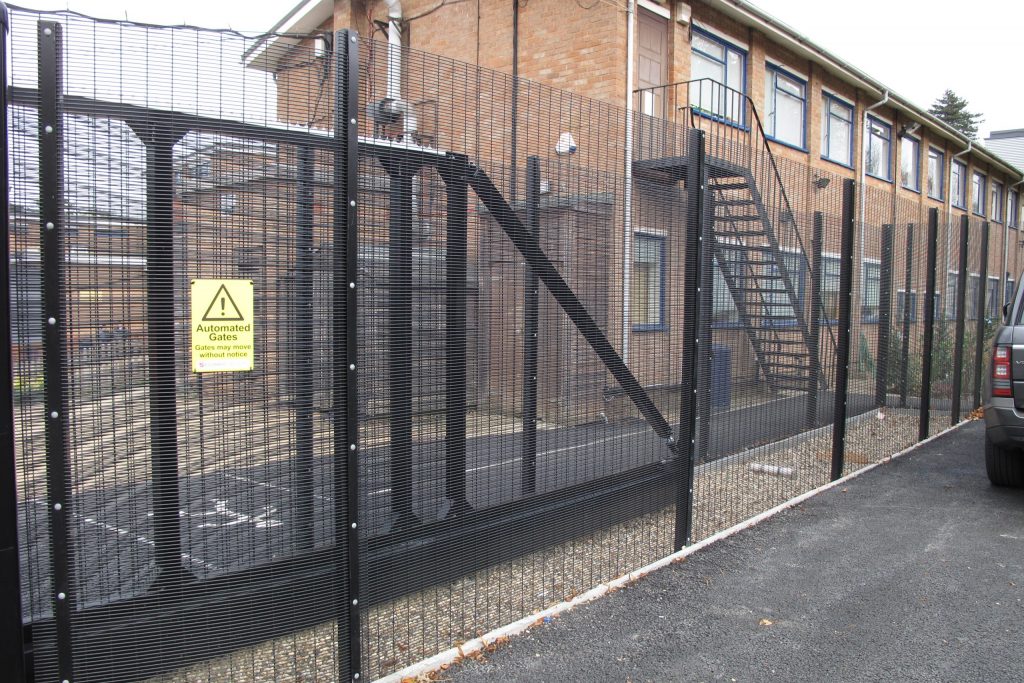As more and more brand new gates are being installed automated, or being retrospectively automated, it’s important for both the users and installers to understand the safety issues surrounding these improvements. By adding a motor to a gate it can turn the gate into a lethal machine – so necessary steps must be taken to assess and mitigate any dangers, by implementing design changes and safety devices.
This page will inform you of the key issues surrounding gate safety, and what rules and standards enforce them, and methods to mitigate risk.
The Machinery Directive
Automated Gates & Barriers are classified as Machines, and therefore must legally comply with the level of safety set out by the Machinery Directive 2006/42/EC. This was brought into UK law by the supply of Machinery safety regulations 2008. This is a basic set of requirements of safety standards that applies to all manufacturers who sells their products to the European market. Once installed, these products must be issued with a declaration of conformity, a CE mark on the machine, and retain a technical file.
New powered gates & barriers must satisfy the Essential Health & safety Requirements as describe in Annex 1 of the directive. A risk assessment must also be carried out to identify all of the potential hazards present, and which of the essential health and safety requirements are applicable.
Hazards identified in a risk assessment can often be characterised by the following:
- Crush hazards
- Impact hazards
- Draw in hazards
- Sheer hazards
- Entrapment hazards
- Hooking hazards
- Cutting hazards
- Electrical hazards
These hazards must be mitigated where possible by implementing correct design and safety devices.

European standards

Standards are made by experts which represent their field sharing their knowledge and understanding the industries crucial needs. The standard is an agreed way of doing things that others in the industry should follow. Relevant standards represent the ‘state of the art’ and therefore what is considered reasonable and practicable to achieve by the industry.
British/European standards BS EN 12453:2017 & BS EN 12604:2017 is a recently revised European standard on the safety of doors, gates and barriers. These are just some of the standards that forms the Machinery directive. BS EN 12453:2017 concerning the safety requirements and tests for powered doors, gates and barriers primarily for vehicular use, and BS EN 12604:2017 concerning mechanical requirements and tests for the safety of both powered and non-powered versions.
These new standards are a major step forward in helping to define the ‘state of the art’ for all products in scope, especially for the safety related parts of the control system on which these products depend for safety. They maintain the previous requirements for basic strength, stability and testing, including where force limitation is the primary means of delivering safety. The requirement on force limitation is not to exceed the existing force limits (400 N for crushing and 1400 N for impact).
Legal Responsibility

The diagram to the left breaks down which legislation is important to gate safety and why powered gates must be safe.
The Heath & safety at Work act 1974 says that Criminal responsibility is put onto employers of premises with powered gates & anybody repairing, maintaining or modifying powered gates. For example, this would be the school and the maintenance company who looks after the powered gate.
Feeding into the Heath & Safety at Work Act is the Machinery Directive 2006/42/EC (bought into UK law via The supply of Machinery (safety) regulations 2008) says it Places criminal responsibility for compliance on the gate manufacturer. Therefore the gate must be safe when first supplied & ensure gate can be maintained safely. This would be the gate installer.
Equally important The Electricity at work regulations 1989 – it is a Statutory UK legislation – all works must conform to BS IET wiring Regulations.
These are a comprehensive set of regulations that legally puts the responsibility onto the employer, installer and maintenance company. Therefore, it is imperative not to neglect the maintenance of a gate, and to carry out any safety works required. See our services & maintenance page here.
Failure to exercise a duty of care in the specification, design, installation, or operation of compliant automated gates may expose the specifier, client and site operator open to litigation in the event of an accident involving injury or damage to property.
For more information, please see the links below from the HSE website:
Duty of care

Commercial power gates
As a gate installer and manufacturer, Securafit has a duty of care to make sure any gate we are involved with is left in a safe state. This includes any maintenance/retrospective work on gates we did not originally manufacture. The most recent gate installer/maintenance company to work on a gate is responsible for the safety of that gate. Securafit is obliged by law to make sure that gate complies with the relevant safety standards. This does not detract from the landlords/employer’s/owner’s responsibilities under health and safety legislation, who are also responsible for making sure the gate has the relevant safety equipment and is maintained in working order.
This means that any retrofitting work involves a complete risk assessment prior to starting. As a result of the risk assessment, additional works may need to be carried out to make the gate safe. If a gate cannot be left in a safe state, we must turn the gate off (i.e. leave it in manual mode) until the problem is resolved & the gate is deemed safe. However we cannot prevent the client from turning the gate back on and continue using it should they wish.
Domestic power gates
In a purely domestic setting: the responsibility of the gate is down to the gate installer/manufacturer. under the Heath & safety act 1974 section 3, Any work carried out on that does not result in a safe gate is breaking a criminal law.
Force testing
This is the act of testing a gate or barrier for the forces it exerts in different positions & movements. Should something come into contact with the gate during operation, there is a maximum force that an automated gate should exert by law, before stopping and backing off in the reverse direction. this test is repeated and different heights and positions on the gate during its operation.
All our automated gates & barriers are tested and calibrated before being signed off and CE marked.

What is DHF?
DHF is a none profit trade association for companies associated with Doors, shutters, Automated gates. They provide its members with technical advice, breakdowns, and training on how best to conform to the safety standards set out by the Machinery Directive.
As a member, we are bound to DHF’s code of practice. This insures we supply, install and maintain our products in a way that is recognised as safe and trusted.
Besides reducing the chance of injury – having a safe gate installed mitigates the user’s liability in the event of an unforeseen incident.

Case studies
In 2010, two separate incidents within a week of each other resulted in the tragic death of 2 children. This highlighted the safety issues that surround the UK automated gate industry. This was exacerbated by the recent prosecution of a gate manufacturer, for breaching Health & safety laws, which resulted in another child fatality.
In one case, which happened in Manchester, the necessary safety devices were not turned on. The gate failed to recognise the trapped child, and instead was programmed the motor to keep pushing, exerting forces greater than a quarter of a ton. The child was eventually freed, but later died in hospital. The installer was found guilty of corporate manslaughter.
A near identical incident happened a few days later in South Wales. An automated gate with insufficient safety devices trapped another child, who was playing in the car park area. The two companies involved pleaded guilty to breaching safety laws.

Methods of mitigating risk:

TETHERS
The most recent safety device recommended – the aim of the tether is to secure the gate leaf and mitigate damage in the event of hinge failure. These ultimately prevent the gate leaf from falling onto the ground and potentially causing catastrophic damage.

FLASHING BEACON
A bright yellow flashing light, acting as a visual cue that the gate/barrier is in operation. flashing beacons are positioned on top of a post and flash shortly before and throughout the gates cycle. Many consider these fundamental, especially in a commercial setting to let people know nearby the gate is about to operate.

PHOTOBEAMS
Otherwise known as optical trip beams. working as a pair, the devices sends & receives an optical signal to one another typically across the pathway of the gate/barrier. When an obstruction blocks the beam, the controller will recognize the signal and prevent the gate/barrier from operating any further. These are excellent are preventing vehicles from getting too close to an operating gate/barrier.
we install minimum 1x pair on the gate and another pair set back in the open position. For gates used by lorries/larger vehicles, we use a minimum 2x pairs at different heights on the gate posts and again set back.
![DSC_0093[1]](https://www.securafit.co.uk/wp-content/uploads/2020/10/DSC_00931-1024x683.jpg)
SAFETY EDGES
These are soft rubber strips mounted onto the leading edge of a gate/barrier that can detect any obstructions it comes into contact with. When meeting an obstruction, the rubber strip compresses, creating a short circuit. The gate controller recognizes this short as an obstruction and stops the motor, before sending it into reverse. This is an ideal last line of defence for a gate.
![DSC_0099[1]](https://www.securafit.co.uk/wp-content/uploads/2020/10/DSC_00991-1024x683.jpg)
FIRE BRIGADE SWITCH
A specialist lock that allows emergency services to open a gate in the event of an emergency. This lock is typically located on the left gate post and is installed on virtually every automate vehicle gate we install.

LIGHT CURTAINS
Similar to the photo beam, this is an optical trip wire device except it has a optical trip beam every 45mm, making it virtually impossible for someone to pass through the devices field of view undetected.
This device is best positioned around the danger area/ area of operation of the gate, with the intention of creating a virtual fence – thus preventing the gate from operating further should someone cross this fence.

COMPOUND FENCING
Compound fencing is unique to Sliding Gates; this is effectively a cage that surrounds the sliding gate when its in the open position. The purpose of the compound is to keep people away from the sliding gate when operating – mitigating crush, shear and impact hazards.
Compounds can come in two forms – ‘loose’ & ‘tight’. A loose compound is simply a fence that surrounds the sliding gates’ runback area. Depending on the size of the gate & infill will determine how far the fencing is setback from the gate, (to mitigate reach in and reach over hazards). However, the loose compound will have a larger footprint compared to the tight compound.
A tight compound is ideal where space or security is a priority. This compound comes with a roof, therefore allowing it to be far more compact and reducing the compound’s footprint. It’s also virtually impossible to climb into the compound.


CRUSH PROTECTED ZONE
A crush protected zone is a designated area that provides space between an operating gate and a fixed object, such as a wall or a pillar. The idea of this crush protection zone is to provide someone with sufficient space to stand and not be crushed by the gate against the fixed object. This is to be designed in conjunction with other safety devices, e.g. safety edges to prevent impact hazards.
The crush protection zone must be a minimum of 500mm between the fixed object and the gate.

